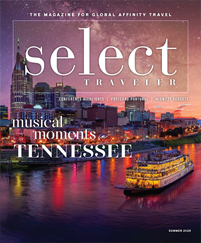The southeast corner of Virginia sparkles with attractions, historic sites, natural wonders, food experiences and municipalities — but not a totally unifying identity. A dozen cities and organizations now promote the expansive region as Coastal Virginia.
“Visitors don’t really care about city limits signs,” said Jim Coggin, tourism sales manager for the Virginia Beach Convention and Visitors Bureau. “All of us [in tourism] want people to explore the region. We want people to stay, to hub and spoke, and to enjoy all of Coastal Virginia.”
Here’s a look at four of Coastal Virginia’s big destinations.
Virginia Beach
With almost half a million residents, Virginia Beach is the state’s most populous city. The municipality, famous for its beachfront, spreads across 500 square miles, and groups can enjoy it on land, in the air and on the water.
On land, the star is the three-mile-long Virginia Beach Boardwalk. On one side is the glistening Atlantic Ocean, and on the other are vendors, outdoor restaurants, hotels and other businesses, plus four stages (nightly entertainment in summer).
Perhaps the most photographed boardwalk “celebrity” is at 31st Street. There stands King Neptune in bronze, 24 feet tall and tipping the scales at 12 tons. The statue is the gateway to Neptune Festival Park. Get a group photo, watch surfers, rent some bikes, soak up the sun — the boardwalk indeed has variety.
To get up in the air, visit the Military Aviation Museum, one of the world’s largest private collections of World War I and World War II aircraft. Among them a Curtiss P-40 (of Flying Tiger fame), a P-51 Mustang, a B-25 bomber, a PBY Catalina flying boat, a Curtiss Jenny, a Sopwith Strutter and even a bright red Fokker DR1 triplane like the Red Baron flew in World War I.
While eating a box lunch, groups can visit with pilots and mechanics who fly and work on the airplanes. Some groups arrange a vintage biplane flight and have a contest or drawing to see who gets to fly over the beachfront.
A popular on-the-water experience is a Virginia Aquarium outing to see migrating whales in winter and bottlenose dolphins in other months. Its boats, the Atlantic Explorer and the Atlantic Scout, get close to nature’s action.
Coggin also brags on four institutions — collectively the Virginia Beach History Museums — that offer interesting group tours such as a Colonial tea, a historic lantern tour and a haunted stories tour.
Hampton
“’First from the sea, first to the stars’ is a slogan Hampton enjoys using,” said Bruce Newton, Hampton’s vice president of tourism.
“Sea” refers to the arrival of European colonists’ sailing ships here 400 years ago. “Stars” refers to Hampton’s role in America’s space program because of the NASA Langley Research Center. Space history is on prominent display downtown at the Virginia Air and Space Science Center. It chronicles more than a century of aviation history, showcases more than 30 aircraft and has a hands-on space exploration gallery.
Because of Hampton’s strategic Chesapeake Bay location, its history has many chapters. Groups explore much of that history at Fort Monroe, the largest stone fort in America. The stories told here in a new $9 million visitor center predate the fort’s construction.
It was here that the first enslaved Africans arrived in English North America in 1619. It was here that the English and Native Americans clashed. It was here that a moody soldier named Edgar Allen Poe served. It was here that enslaved men sought refuge during the Civil War. And it was here that Confederate President Jefferson Davis was held briefly after the Civil War. (After exploring the visitor center, check out the Casement Museum inside the fort.)
Efforts to educate the formerly enslaved led to what now is Hampton University, and the Hampton University Museum is another recommended destination. It is the oldest Black museum in the U.S. and one of the oldest museums in Virginia.
“The Hampton University Museum is a treasure that more people need to visit,” Newton said.
Another, he said, is the Emancipation Oak. This gigantic tree was the site of the first Southern reading of Abraham Lincoln’s Emancipation Proclamation. The National Geographic Society labeled the Emancipation Oak among “the 10 Great Trees in the World.”
Newport News
All of Coastal Virginia has a maritime history, but Newport News has some special claims. For instance, Newport News Shipyard is where all American aircraft carriers are built; remnants of the USS Monitor, the federal ship in the first battle between ironclad ships, are here; and dozens of trawlers that ply nearby waters for seafood served at the region’s restaurants call the city home.
So much seafaring lore is here that the Mariners’ Museum has a congressional designation as “America’s National Maritime Museum.” Visit the museum, located in a 550-acre park, to see some of its 35,000 artifacts — model ships, wooden figureheads, paintings, small craft from around the world.
Shift gears inland at the Virginia Living Museum to sample outdoor Virginia’s adventures. Its exhibits cover the entire state, from the misty Appalachians to the sometimes-foggy Atlantic coastline. Displays feature 250 animal species.
A special treat is the Newport News Park — 7,780 acres of woodlands, lakes, trails, Civil War fortifications and more. Ranger Robert Brooks and others lead numerous hikes and programs for groups, and Brooks also is a step-on guide for tours on numerous topics. His college work was in political science and history, and he’s been a historical reenactor, so he knows his stuff.
Another Newport News tour attraction is scattered through the city. It’s a public art driving tour past more than three dozen outdoor sculptures and memorials.
Norfolk
Variety is the watchword for Norfolk. Groups can tour a battleship, admire 5,000 years of art, watch glassblowing demonstrations, explore a very art-conscious neighborhood or get some exercise on an urban waterfront trail — and that’s just the start.
Nauticus is a logical component of any itinerary. This maritime discovery center is on the downtown waterfront, and indoor attractions include a new interactive exhibition called “Norfolk in Time,” a newly designed aquarium space and an explanation of Norfolk’s importance in worldwide ocean commerce.
Its gigantic exhibit is the USS Wisconsin, the largest and last battleship that the U.S. Navy built. It served from World War II through the First Gulf War and officially became a city of Norfolk facility in 2010. Groups can explore much of the massive ship on their own or arrange guided tours.
A more placid setting is the Chrysler Museum of Art, where 50 galleries display a portion of the museum’s more than 30,000 paintings, sculptures and other pieces. A special treat is the museum’s Perry Glass Studio, which offers narrated glassmaking demonstrations Tuesday through Sunday.
Leaving the Chrysler, groups can stroll or ride through the NEON (New Energy of Norfolk) District, Norfolk’s first official arts district, to admire colorful murals, do some shopping or perhaps catch a show at the Push Comedy Theater.
Of course, you can get out on the water, too, with a Victory Rover Naval Base Cruise or an American Rover Sailing Cruise.









